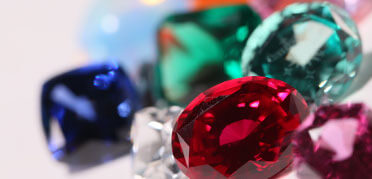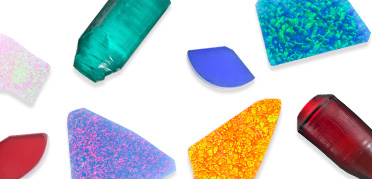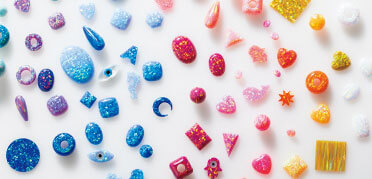Jewelry Glossary
-
C
-
Cable Chain
A cable chain is a basic form of chain. The shape of each ring in the chain is either rounded or squared.
The circle can be oriented in two ways; front and side. The chain is simplistic, and does not make too bold of a statement. By using this chain, you can make a pendant top stand out, or add delicate impression to accessories. -
Cabochon Cut
Opaque/translucent gemstones are usually cut to a cabochon cut. This cut can emphasize luster or patterns such as a star on the gemstone's surface. In order to emphasize the asterhythm and the cat's eye effect, gemstones tend to be cut into a high cabochon.
High cabochon has higher dome (height), and low cabochon has lower dome (height).
Cabochon cut gemstones with a flat bottom are called single cabochon, and the gemstones with a round bottom are called double cabochon.
Also, there is a cut called hollow cabochon which, has a dented bottom that allows light to shine through the gemstones well. -
Calcite
Calcite is a single crystal, and the length is several meters but most of it is a lump and mined as limestone and marble. It was also used for architectural materials from ancient times.
[Moh's hardness: 3] [Mineral species: Calcite] -
Cameo
Jewelry with embossed carving in agate and shells.
-
Cantera
Cantera is a precious opal cut (polished) with mother rock. It started to sell at market in the 1980s to reduce resources and price.
[Moh's hardness: 5] [Mineral species: Opal] -
Carat
Carat, abbreviated as "ct," is a unit of weight for gemstones, and it comes from carob beans. The weight of a single carob is around 0.2g, so 1ct means 0.2g and has been used worldwide since 1911.
-
Carnelian
Carnelian is characterized by a translucent reddish orange. In the past it was believed to be able to bring down fevers. The orange coloring is due to iron content. It is usually cut into cabochon, beads, and tumbled to make natural-like jewelry.
[Moh's hardness: 6] [Mineral species: Chalcedony] -
Carnelian Onyx
Onyx is a clear agate with white stripes.
If the base color is black, it is simply called "onyx" however if the color is red or orange, it is called "sardonyx."
If it has higher transparency than "sardonyx," it is called "carnelian onyx." Carnelian onyx is generally opaque but also you can find attractive pieces from translucent stones.
[Moh's hardness: 6] [Mineral species: Chalcedony] -
Casting
Casting is a metal processing method that runs melted metal into a mold first, and then cools the metal to solidify it.
-
Cat's Eye
Cat's eye usually refers to chrysoberyl cat's eye. It shows a tight vertical line within the stone under light. The name is derived from its likeness to a feline's eye. This effect is called "chatoyancy," the name originates from the French word "chat" which means cat.
In Sri Lanka, it was said that cat's eye is "a gemstone that protects from evil spirits." At the end of the 19th century, it was considered a valuable stone second only to diamonds with the name "oriental cat's eye."
[Moh's hardness: 8] [Mineral species: Chrysoberyl] -
Center Stone
Usually, the center stone is set on the highest/top position in jewelry/products.
-
Chain Bracelet
The chain bracelet follows the movement of the wrist. A heavy chain, such as kihei chain, is usually preferred by men.
The length of chain bracelet is between 16-18 cm for women and 21 cm for men. -
Chain Ring
A chain ring is produced by putting chains around one's finger and braze.
-
Chain Tag
A chain tag is a connecting part of a necklace.
It is set at the opposite side of a spring ring. -
Chalcedony
Chalcedony is quartz where the crystals are invisible to the naked eye and is quartz of bulk crystalline minerals.
In natural forms it is produced in chunks such as mammillary shape, grapes shape, or stalactite form. It is mostly translucent.
[Moh's hardness: 6] [Mineral species: Chalcedony] -
Channel Setting
Channel setting fixes gemstones with a rail-shaped metal from both sides.
It is often used to set melee size gemstones to fix multiple stones in a row. -
Charm
Charms are small pendant shaped ornaments attached to rings, earrings, chain bracelets, and anklets. Usually, they are removable. Originally, charms were referred to as amulets, nowadays they are regarded as a fashionable item.
-
Charm Ring
People used to wear charm rings as an amulet and believed that it protects themselves from evil. We can enjoy the movement and there are many types of decorations such as animals, instruments, hearts, ribbons, etc.
-
Chrome Diopside
Chrome diopside contains a lot of chrome and also calcium, and magnesium. As the double refractive rate is high, it was named "diopside." Diopside means "two views" in Greek. It turns green when chrome is included. Considering the hardness and cleavage, it is better to cut to cabochon, and some of them may show chatoyancy.
[Moh's hardness: 5] [Mineral species: Diopside] -
Chrysoberyl
Chrysoberyl is mainly polished to the following three gems depending on its characteristic.
-Alexandrite, that changes color by light source.
-Cat's Eye that shows chatoyancy effect.
-Chrysoberyl, which has no special effect.
It is an oxide of aluminum and beryllium.
The hardness is second to corundum and it is durable.
Crescent Vert green chrysoberyl features a refreshing bright green color with refined transparency. Please click
here
to learn more about Kyocera's Crescent Vert green chrysoberyl.
[Moh's hardness: 8] [Mineral species: Chrysoberyl]

Green Chrysoberyl
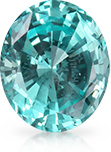
This gem’s name combines the Greek words chrysos (gold) and its chemical element Beryllos (shining gemstones). The popular gemstone is famous for its crisp green transparent sparkle. In Asia, chrysoberyl is believed to protect the wearer from evil. Crescent Vert green chrysoberyl features a refreshing bright green color with refined transparency.
Available in sizes up to 10 carats.* If you need a larger stone, please contact us.View Comparison Table Item Crescent Vert Green Chrysoberyl Natural Green Chrysoberyl Chemical Composition BeAl2O4 BeAl2O4 X-ray Diffraction Same as natural stone A pattern specific to Green Chrysoberyl Spectroscopic Analysis Same as natural stone Specific absorption of Green Chrysoberyl Crystal system Orthorhombic Orthorhombic Mohs Hardness 8.5 8.5 Specific Gravity 3.71 3.71 Melting Point 1870℃ 1870℃ Transparency Transparent Transparent Refractive Index 1.737~1.745 1.738~1.746 Double Refraction 0.008 0.008 Average Dispersion 0.015 0.015 Pleochroism Yellowish green, Green, Bluish green Yellow green, Green, Bluish green Chelsea Color Filter Examination Slight red Dark red -
Chrysocolla
Chrysocolla is derived from a "kolla," meaning glue and "chrysos," meaning gold in Greek.
Usually, it has been mined in a green or blue lump and has marble patterns combined with other minerals. It is often combined with quartz and opal, which makes the stone harder than itself. The hardness of chrysocolla has a width of 2 to 4.
[Moh's hardness: 2-4] [Mineral species: Chrysocolla] -
Chrysoprase
Chrysoprase is a green chalcedony. The most valuable chalcedony displays extremely beautiful hues of green. It has been used as a luxurious decorative stone for the interior decorations of chapels and castles. Even now, it is usually used for jewelry polishing into cabochon cuts, beads, and tumbled. Since the green of chrysoprase is caused by nickel content, the color will fade if the gem is either exposed to the sun for a long time or heated.
[Moh's hardness: 6] [Mineral species: Chalcedony] -
CIBJO
The official name is Confédération Internationale de La Bijouterie, Joaillerie, Orfèvrerie, Perles et Pierres (English: International Confederation of Jewelry, Silverware, Diamonds and Stones).
The advisory body of the United Nations has set up rules related to jewelry. -
Citrine
Citrine's name is derived from "citron" meaning lemon in French. The yellow color of citrine is derived from iron, but the amount produced is limited. In 1883, by sheer coincidence, it was discovered that amethyst changes to bright yellow by heat treatment.
So, currently, most citrines are heat treated amethysts. In addition, citrine that changes to deep orange is called madeira citrine because it is similar to Madeira wine.
[Moh's hardness: 7] [Mineral species: Quartz] -
Clasp
A clasp is the fastening part of a necklace. "box clasp" and "fold-over clasp" are two popular clasp variation types.
-
Cleavage
Cleavage refers to the tendency of a mineral to split along defined planes.
When setting a gemstone that has cleavage, it must be handled carefully.
Cleavage occurs due to the array of atoms inside the crystal. -
Cleaving
Cutting a rough diamond into two separate pieces and removing inclusions near the surface. The diamond needs to be cleaved along the diamond's tetrahedral plane with a knife. Cleaving will usually be done when cutting a large diamond that is more than 1ct.
-
Cluster Setting
In a cluster setting, melee gemstones are set closely together. The gemstones in a cluster ring often form a geometric shape like a square or a unique design like a flower. Many cluster rings have an antique look and European style.
-
Coarse Surface (Granular Finish)
Coarse surface is produced by blasting emery (garnet grain). A sand blaster machine is also used to make this surface texture.
-
Coating (Treatment)
Coating is the process of painting the stone to upgrade a diamond's color or make colored stones pink or darker.
-
Cocktail Ring
Cocktail ring has no main stone. There are many types of multi-stone rings but the ring that has various combination of color stones are called cocktail ring. This name comes from cocktail (blended liquor) because the appearance is similar.
-
Coil Chain
A coil chain is a type of chain in which rings are continuously connected. The cable chain and kihei chain are examples of this type of chain.
-
Collage Ring
The college ring is a ring with school emblems and or symbols of university. It is also called school ring and students of the same school wear it. It is also used as an admission souvenir and a graduation souvenir. Classmates may also wear a "class ring."
-
Collar Bar
The collar bar is a rod-shaped pin with a spring on one of its sides.
-
Color Zoning
Uneven distribution of color is seen inside a gemstone.
-
Color-change Effect
Color change is one phenomenon (effect) that certain gemstones exhibit. For example, gems seem green or blue under natural light but change color to red under incandescent light. We can see this phenomenon in alexandrite, spessartite, pyrope minerals, etc.
-
Colorless Topaz
A colorless topaz can be mistaken as a low-quality diamond when polished to a brilliant cut. Topaz has been a substitute for diamond along with zircon until synthetic cubic zirconia was manufactured and popularized in 1977. It is rarely used now and the cost for polishing makes up a substantial portion of the total value.
[Moh's hardness: 8] [Mineral species: Topaz] -
Common Opal
Common opal is opaque, and it doesn't show the play of color. Many are used as abrasives or heat-insulating materials and sold at a low price.
-
Conch Pearl
Conch pearl is produced from pink shellfish (conch shellfish). Pink, red, orange, yellow, brown and white pearls can be collected. There are no pearl layers, and it does not show the pearl gloss. Its unique color and shape are attractive and beautiful, so it is called conch pearl. Currently, to prevent overfishing, there is an area that prohibits collecting.
We can not insert a nucleus bead and cultivate pearls as it is a conch. In conch pearls, we can see "fire patterns," which seems like flames are burning. It is important to treat it carefully because cracks and discoloration will be caused by heat, easily cracked and sensitive to acid.
[Moh's hardness: 2.5-3] [Organic matter: Conch pearl]" -
Conflict Diamond
Conflict diamonds are diamonds mined in a war-stricken zone and are typically used to finance armed conflicts.
-
Convertible
Convertible is a design name for pearl necklaces.
Two clasps are used so you can either use it as a long necklace, or divide it into a necklace and a bracelet. -
Coral
In Scotland, there is a legend that "coral brings beauty and prosperity to girls." The colors are red, pink, and white, but the one with bright red like blood is popular. The quality of the coral is distinguished by the form, color unevenness and whether it is worm-eaten or not. It is better to wear it on the clothes rather than directly because it is sensitive to acid such as sweat. There are some corals colored or bleached in the market.
[Moh's hardness: 4] [organic matter: Coral] -
Cornflower Blue
Cornflower blue is one of the colors of sapphire, it is a delicate dark bluish purple featuring a soft luster. It was mainly produced in the Kashmir region in 1881, but now it is rarely produced so it has become more valuable.
-
Corundum
Corundum is named after kuruvinda which means ruby in Sanskrit.
It's hardness is only second to that of diamond.
Red corundum is more commonly referred to as ruby, blue colored variants are called sapphires.
At the beginning of the 18th century, people discovered that both ruby and sapphire are made of an aluminum oxide called corundum. -
CRESCENT VERT
Lab-grown gemstones brand which is exclusive to Kyocera. It is chemically, physically and optically identical to natural gemstones and the only difference is their origin. Crescent Vert gems are grown with care in an immaculate laboratory environment.
There are 13 kinds of gems in the collection.
Please click here to learn more about Crescent Vert. -
Crown
The crown is the top part of a girdle of loose stones. Please kindly refer to the image of the brilliant cut for details.
-
Crown Setting
The crown setting, which has six prongs, is generally used for round brilliant-cut diamonds. It is also called tiffany setting, named after a jewelry brand that developed this setting.
-
Cuff Links
Cuff links are a piece of jewelry used for securing the cuffs of a shirt. For its shape, there are "box types," "round types," and "boat types."
The clasp is inclined so it will be easier to put onto the shirt.
It is usually symmetrical and often designed with a tie holder and sold as a set. -
Culet
The culet is a small facet at the bottom of loose stones. Some cut shapes don't have a culet. Please kindly refer to the image of the brilliant cut for details.
-
Cultured Pearl
Cultured pearl was started by a Japanese businessman, Koukichi Mikimoto and his colleagues in the 1890s. Inserting small nucleus beads to mother shells (insertion), stimulating molluscan tissue of mother shells to promote the secretion of pearl components and let the pearl form layers. Then, it enables collection of full spherical pearls.
-
Cushion-shaped Cut
The cushion cut is characterized by its rounded rectangular shape. It is the origin of the brilliant cut.
-
Cut Ring
A cut ring is made by adding a cut to a simple domed band or flat band.
-
CVD (Chemical Vapor Deposition Process)
CVD is a production method of lab-grown diamonds.
The process involves introducing a gas, such as methane, into a vacuum chamber then activating and breaking down the gas molecules with microwaves. This causes the carbon atoms to accumulate on a substrate (a small flat diamond seed crystal). -
Czochralski Process
The czochralski process is one of the production methods of purity lab-grown gemstones (single crystals). This process was developed in 1916 by a Poland chemist Dr. Jan Czochralski. Many gemstones are grown by pulling the seed crystal very slowly from melted material in the crucible.
This process is also called the "CZ process" or "pulling process."
Kyocera grows
ruby
,

Ruby
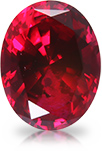
The deep red color of ruby conjures passion and sensuality. Treasured since ancient times, ruby was used in amulets and secret medicines. Second only to diamond in hardness, ruby is made of corundum alumina. The finest natural rubies from Myanmar are called “pigeon blood” rubies, prized for their bright red, slightly purplish hue. Crescent Vert ruby is grown with care to radiate the enchanting crimson color and high transparency of natural stones.
Available in sizes up to 10 carats.* If you need a larger stone, please contact us.View Comparison Table Item Crescent Vert Ruby Natural Ruby Chemical Composition Al2O3 Al2O3 X-ray Diffraction Same as natural stone A pattern specific to Ruby Spectroscopic Analysis Same as natural stone Specific absorption of Ruby Crystal system Hexagonal Hexagonal Mohs Hardness 9 9 Specific Gravity 4.01 3.90~4.01 Melting Point 2050℃ 2050℃ Transparency Transparent Transparent Refractive Index 1.762~1.770 1.760~1.768 Double Refraction 0.008 0.008 Average Dispersion 0.018 0.018 Pleochroism Yellow-Red, Bright red Pale yellowish red, Pale red Chelsea Color Filter Examination Strong bright red Strong bright red sapphire
,

Sapphire
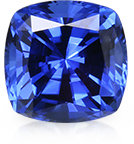
While sapphire comes in many colors, deep blue sapphire is the most famous and the standard against which other blue gemstones are measured. This ancient gemstone is said to bring wisdom, protect the wearer from evil, and promote healing. Its bright blue sparkle has been loved for centuries as a symbol of the heavens and source of faithfulness and peace of mind.
Our Crescent Vert blue sapphire is highly valued for its cornflower blue color.Available in sizes up to 10 carats.* If you need a larger stone, please contact us.View Comparison Table Item Crescent Vert Blue Sapphire Natural Blue Sapphire Chemical Composition Al2O3 Al2O3 X-ray Diffraction Same as natural stone A pattern specific to Blue Sapphire Spectroscopic Analysis Same as natural stone Specific absorption of Blue Sapphire Crystal System Hexagonal Hexagonal Mohs Hardness 9 9 Specific Gravity 4.01 3.90 ~ 4.00 Melting Point 2050°C 2050°C Transparency Transparent Transparent Refractive Index 1.762 ~ 1.770 1.760 ~ 1.768 / 1.770 ~ 1.779 Double Refraction 0.008 0.008 ~ 0.010 Average Dispersion 0.018 0.018 Pleochroism Pale greenish blue/dark blue Pale greenish blue/dark blue Chelsea Color Filter Examination Unchanged Black green, Unchanged alexandrite
and

Alexandrite

Alexandrite reveals different colors under various lighting conditions. In the sun, it’s a deep blue-green. By candlelight, it looks purplish-red. Collectors covet this stone and its mysterious color signature, caused by trace amounts of chrome within the gem. Crescent Vert alexandrite possesses the same vivid color-changing properties as high-grade natural stones from Russia’s Ural Mountains.
Available in sizes up to 10 carats.* If you need a larger stone, please contact us.View Comparison Table Item Crescent Vert Alexandrite Natural Alexandrite Chemical Composition BeAl2O4 BeAl2O4 X-ray Diffraction Same as natural stone A pattern specific to Alexandrite Spectroscopic Analysis Same as natural stone Specific absorption of Alexandrite Crystal system Orthorhombic Orthorhombic Mohs Hardness 8.5 8.5 Specific Gravity 3.71 3.71~3.72 Melting Point 1870℃ 1870℃ Transparency Transparent Transparent Refractive Index 1.743~1.752 1.747~1.757 Double Refraction 0.009 0.01 Average Dispersion 0.015 0.015 Pleochroism (Daylight)
Bright bluish green, Pale yellow, Dark purplish red
(Incandescent light)
Bluish green, Pale yellow, Reddish purple(Daylight)
Bright green, Pale yellow, Red
(Incandescent light)
Bright green, Reddish yellow, RedChelsea Color Filter Examination Red Red chrysoberyl
by applying this method and our know-how.

Green Chrysoberyl

This gem’s name combines the Greek words chrysos (gold) and its chemical element Beryllos (shining gemstones). The popular gemstone is famous for its crisp green transparent sparkle. In Asia, chrysoberyl is believed to protect the wearer from evil. Crescent Vert green chrysoberyl features a refreshing bright green color with refined transparency.
Available in sizes up to 10 carats.* If you need a larger stone, please contact us.View Comparison Table Item Crescent Vert Green Chrysoberyl Natural Green Chrysoberyl Chemical Composition BeAl2O4 BeAl2O4 X-ray Diffraction Same as natural stone A pattern specific to Green Chrysoberyl Spectroscopic Analysis Same as natural stone Specific absorption of Green Chrysoberyl Crystal system Orthorhombic Orthorhombic Mohs Hardness 8.5 8.5 Specific Gravity 3.71 3.71 Melting Point 1870℃ 1870℃ Transparency Transparent Transparent Refractive Index 1.737~1.745 1.738~1.746 Double Refraction 0.008 0.008 Average Dispersion 0.015 0.015 Pleochroism Yellowish green, Green, Bluish green Yellow green, Green, Bluish green Chelsea Color Filter Examination Slight red Dark red
-
